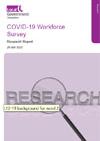This is report is part of a series of bi-weekly surveys of all councils in England, Wales and Northern Ireland collecting key workforce data on how the sector is responding to COVID-19.
View all Workforce articles
This report relates to the survey sent out on 15 July. The overall response rate was 61 per cent and covered over a third of the total workforce.
Key findings
- Some 30 per cent of councils reported recruiting additional staff (of any type including casual, agency, contingent, etc) in the week ending 10 July 2020. In total 5350 additional staff had been recruited: the median number of staff per authority was four and the mean was 86.
- More than a third of councils (106) recorded deaths in service since lockdown. A total of 209 deaths in service were reported since the start of lockdown (cause not specified).
- Twenty-seven per cent of councils reported that they had furloughed at least one member of staff full time. In total there were 7,070 staff furloughed – full time in the week ending 10 July 2020, which was one per cent of the current workforce.
- In addition, thirteen per cent of councils reported that they had furloughed at least one member of staff part time. In total there were 3,435 staff furloughed part time in the week ending 10 July 2020, which was 0.6 per cent of the current workforce.
- The main reason given for furloughing staff was that the service had stopped (57 per cent) or that funding had stopped (29 per cent).
- Some 80 per cent of councils had redeployed staff. In total there were 12,003 staff redeployed in the week ending 10 July 2020, which was two per cent of the current workforce. The median number of staff redeployed was 27 and the mean was 62.
- Just under nine out of ten councils (89 per cent) reported that they had at least one member of staff unavailable for work. In total there were 30,462 staff unavailable for work in the week ending 10 July 2020, five per cent of the current workforce. The median number of staff unavailable for work was 36and the mean was 143.
- 31 per cent of staff were unavailable through ‘self-isolation (other)’ and 37 per cent were unavailable due to ‘non-COVID sickness’.
- When asked whether individual services had enough staff to run them normally or not, the service most badly affected during the week ending 10 July was schools: over a quarter of single tier and county councils reported they were operating with severe disruption due to staffing numbers. Also badly affected were adults and children’s services, with 27 per cent and 18 per cent of councils respectively reporting moderate disruption.
- When asked to assess the council overall, in terms of whether there are enough staff to run services normally or not, 62 per cent of councils report minor or moderate disruption.
- Councils were asked about the availability of personal protective equipment (PPE) and COVID-19 testing for staff. Eighty-nine per cent reported they had about the right amount of PPE they needed; while three per cent had less than they needed. Eighty-four per cent said all the staff who need testing can access it; two per cent said it was available to some of their staff who need it.
- Looking ahead, councils were asked thinking about staffing what they were currently considering doing within this financial year, 31 per cent said they considering increasing apprenticeships and 25 per cent said they were considering reducing the use of contractors or agencies.
- Finally, councils were asked what they were currently considering in terms of staffing locations, 67 per cent were considering increasing flexible working options and 50 per cent were considering changing models of service delivery.
To view an accessible version of this document, please email [email protected].

- Published by:
-
LGA
- Reference code:
